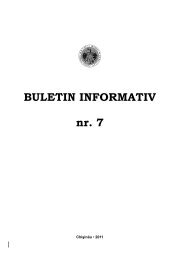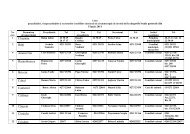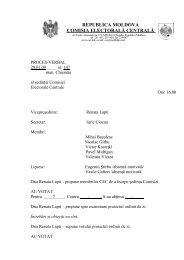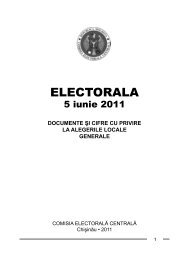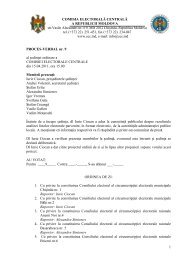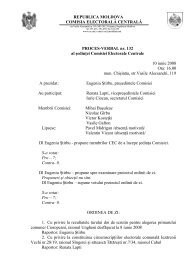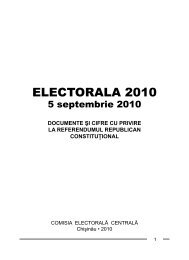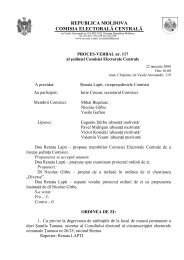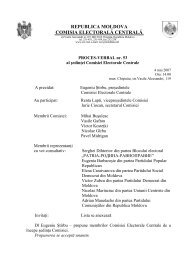noile tehnologii în formarea Åi utilizarea listelor electorale ... - Cec.md
noile tehnologii în formarea Åi utilizarea listelor electorale ... - Cec.md
noile tehnologii în formarea Åi utilizarea listelor electorale ... - Cec.md
- No tags were found...
You also want an ePaper? Increase the reach of your titles
YUMPU automatically turns print PDFs into web optimized ePapers that Google loves.
182<br />
Conferinţa internaţională.<br />
NOILE TEHNOLOGII ÎN FORMAREA ŞI UTILIZAREA LISTELOR ELECTORALE. EVOLUŢII ŞI PERSPECTIVE<br />
Today’s topic is voter registration and many governments and central electoral<br />
commissions around the world use the biometric system. This is a unique system<br />
that ensures that a vote is cast only once, and it is very important that, thanks to<br />
biometric solutions, the voter can be identified accurately and we can create the<br />
register of voters to verify all voters during the electoral process.<br />
What are the stages of a typical electronic voting process The first step may be<br />
voter authentication through many means and solutions. What is used in most<br />
developed countries are digital certificates, the most popular being electronic<br />
ID cards, smart banking cards and, of course, the PKI (Public Key Infrastructure).<br />
Public Key Infrastructure is the most important process in the authentication of<br />
voters. There is another possibility for voter authentication, such as specific identification<br />
of voters that can be provided to voters in several ways: by mail, email,<br />
phone cards and SMS. Of course, the most important thing is security; these data<br />
should be delivered to the proper voter. Other authentication mechanisms are<br />
also available, but this certainly depends on the client.<br />
The second important step of the electronic process is creating an electoral council<br />
and receiving by each member a private key to have access to all digital votes.<br />
It is very important that at the end of the electoral process the members of the<br />
CEC or central body can open the votes and check the voting results. As already<br />
mentioned, the voting process can be done in several ways, for example using<br />
smart cards or optical scans. People in some countries prefer paper ballots, and<br />
as already mentioned, older people are not familiar with electronic solutions.<br />
But I could exchange experiences and confirm that older people liked the touch<br />
screen method, they understood that the process is very easy and well developed<br />
for these categories of people. After the voting process, voters can receive a confirmation<br />
that their votes were counted.<br />
After the voting is closed, the committee reconstructs the private keys and opens<br />
the digital ballots, after which the results and the confirmations are published<br />
and all voters can verify if their votes were counted. If we talk about electoral<br />
modernization, both now and in the future, it is important not to forget about<br />
people with disabilities. Some experience has been gained worldwide, in particular<br />
governments and electoral commissions are thinking of ways to help persons<br />
with disabilities. These are not only people with vision or hearing disabilities, but<br />
also people who cannot come to polling stations and many others; they are taken<br />
into account when we talk about modernizing the electoral process. Many people



